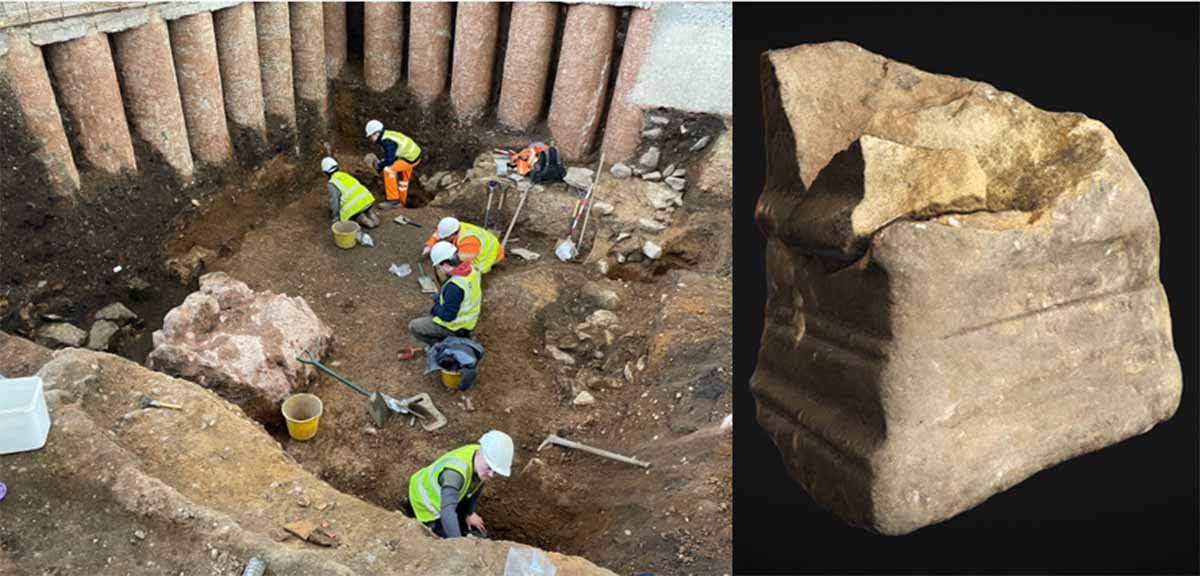Conny Waters – AncientPages.com – Archaeologists at Leicester Cathedral have finished the excavation project and reported discovering an ancient Roman shrine and over 1,100 burials.

The archaeological project started in October 2021. Although it was a modest-sized area, the dig has produced a remarkable amount of archaeological information, allowing us to tell the story of an area of Leicester we rarely get the opportunity to investigate.
“When scientists began the project, they had several key research questions, including when was the parish church of St Martin founded and what was happening on the site in the Roman period.
Archaeologists from the University of Leicester excavate medieval burials at Leicester Cathedral. Image: ULAS
“Our excavations have uncovered over 1,100 burials ranging in date from the 11th century through to the mid-19th century, and we can now be confident that St Martins was founded in the late Saxon period.
These burials will now be analyzed, and the results will give us a unique insight into the lives of the residents of Leicester who have been buried here over the past 1000 years. It is also important to note, once the project is completed, all human remains will be reinterred with care and sensitivity by Leicester Cathedral,” the researchers said in a press statement.

“We have also uncovered rare evidence from the Anglo-Saxon period, including a potential building and the first Anglo-Saxon coin found in Leicester in nearly 20 years. If the building does prove to be Anglo-Saxon, it will be the first evidence of a structure of this period in this part of Leicester and will suggest post-Roman occupation inside the town was more extensive than previously suspected.
In the north-west quarter of the site we have also found the cellar to a Roman building. From it we have recovered the base of an altar stone and this might suggest that this room was a shrine or a cult room in the Roman period,” archaeologists explain.
The cellar is a well-made semi-subterranean structure with painted stone walls and a concrete floor. Today, that floor is over 3m below the ground, and it would have been around a meter below the contemporary Roman ground surface. The decorative paintwork suggests that the space, measuring about four by four metres, would have been used as a reception room rather than as a place of storage, potentially within a larger building such as a townhouse which is mostly to the west of the cellar though that may never be confirmed.

A silver Anglo-Saxon penny (c.AD 880-973). Image: ULAS
The sunken room was probably built in the 2nd century AD and was accessed in the south-west corner via an external passageway. This had timber walls and a flagstone floor. The cellar was deliberately dismantled and infilled, probably in the late 3rd or 4th century, and within the space, lying broken and face down amidst the rubble, we found the base to an altar stone. It is carved from local Dane Hills sandstone, quarried 1 mile west of the site near Western Park, and measures 25cm by 15cm. There are decorative mouldings on three sides and the back is plain, showing that it would have been placed against a wall. Originally, it would have stood higher than it was wide, perhaps around 60cm tall, but it is broken mid-shaft and the upper part of the pedestal and the capital are missing.

The Roman altar stone found during archaeological excavations at Leicester Cathedral. Image: ULAS
Given the combination of a subterranean structure with painted walls and the altar we have found, one interpretation, which seemed to grow in strength as we excavated more, could be that this was a room linked with the worship of a god or gods. What we’re likely looking at here is a private place of worship, either a family shrine or a cult room where a small group of individuals shared in private worship.
Underground chambers like this have often been linked with fertility and mystery cults and the worship of gods such as Mithras, Cybele, Bacchus, Dionysius and the Egyptian goddess Isis. Sadly, no evidence of an inscription survived on our altar, but it would have been the primary focus for sacrifice and offerings to the gods, and a key part of their religious ceremonies.
The discovery of a Roman altar at Leicester Cathedral, the first to ever be found in Leicester, is an amazing find for the Leicester Cathedral Revealed project. For centuries there has been a tradition that a Roman temple once stood on the site of the present Cathedral.

This folk tale gained wide acceptance in the late 19th century when a Roman building was discovered during the rebuilding of the church tower. The origins of this story have always been unclear but given that we’ve found a potential Roman shrine, along with burials deliberately interred into the top of it after it was demolished, and then the church and its burial ground on top of that, are we seeing a memory of this site being special in the Roman period that has survived to the present day?
We may never know, but the next stage of the project, the analysis of the burials, will help us find more answers,” the research team says.